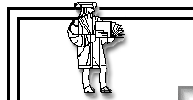 |
 |
|
PatinaPatina is the natural surface changes which occur on ancient coins over centuries of burial or decades in modern collections. While referring mostly to chemical changes to the surface, it can include some types of deposits on the surface. Sometimes the two work together to form patina. There are also false patinas chemically induced or even painted on coins to hide over cleaning. This is a complex subject which I can only touch on here. GOLD COINSUnless buried in a corrosive or abrasive environment gold coins change very little with burial and rarely require significant cleaning other than washing off some dirt. Many come from the ground looking as new. Usually any encrustations on gold coins are easily removed without damage to the coin, but there is on type of pinkish encrustation which I see more on medieval Islamic gold than ancient gold, which can be very difficult to remove and usually should be left alone. 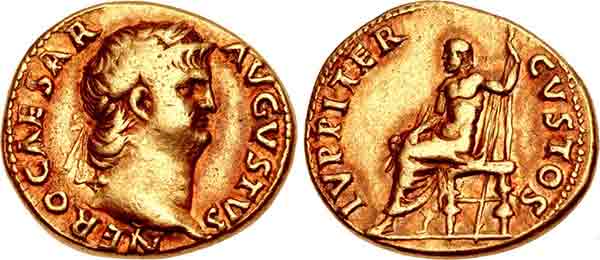 image courtesy of Classical Numismatic Group www.cngcoins.com On rare occasions gold coins with a reddish brown discoloration known as Boscoreale patina. One way a true Boscoreale patina results is from exposure heat and possibly sulfur and is named for the Boscoreale hoard recovered from Pompeii after burial by the eruption on AD 79. It can occur on coins from other sources and I have seen it on coins dating after AD 79. I have never owned a gold coin with Boscoreale patina so in this one instance I have used an image that is not my own on this site. SILVER COINSMany groups of silver coins are found with rather ugly patina from a variety of silver reactions including silver sulfide and silver chloride (also known as horn silver) formation. Only rarely is original hoard patina on silver coins attractive, so cleaning is usually necessary. Processes used to clean silver coins usually turns them very bright but if done properly the surfaces are not harmed and will re-tone over time resulting in old collection toning. 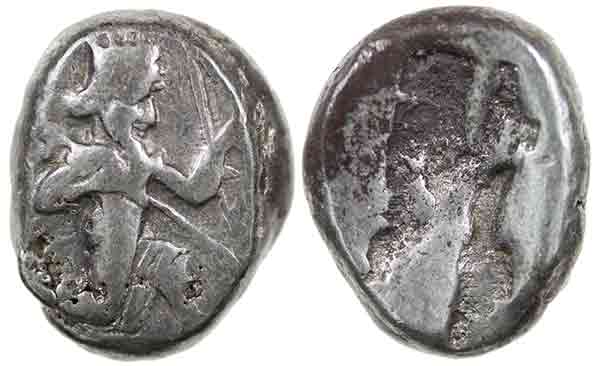
Silver coins with attractive natural hoard patina are unusual but this Persian siglos has silver chloride (horn silver) on the reverse which does not detract. It is my personal feeling coins like this should not be cleaned and can be more desirable like this. 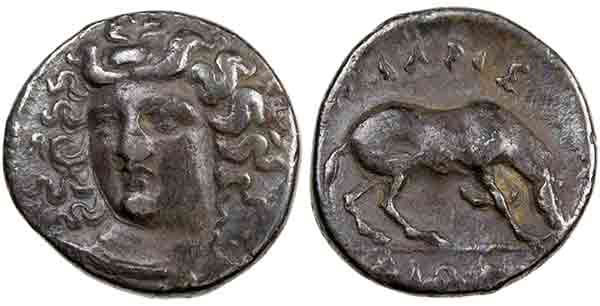
This Larssa drachm has the original hoard patina, probably left intact as it is reasonably attractive with an even color over the entire coin. There is wear to some high points of the patina, as well as a trace of encrustation over the patina on the reverse. Some collectors prefer coins with natural as found patina and some do not. It is a personal choice and there is no firm rule as to how it will affect the value. 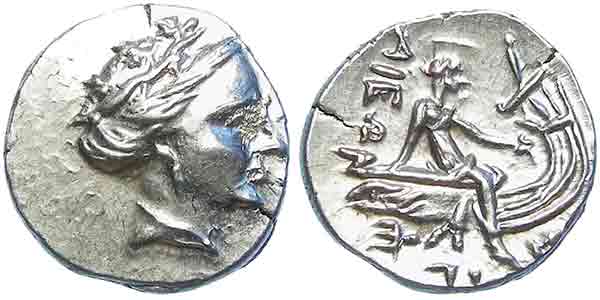
This Euoboia tetrobol has been cleaned of all hoard patina or toning, but it has not be otherwise damaged and given time will develop an old collection toning that probably will look very nice. But right now it is extremely bright. The rough spot at the eye is die deterioration, not damage. There are two schools of thought about toning. More experienced collectors usually prefer toned silver coins and will pay a premium for attractively toned examples. An attractive natural hoard patina is best but since that is so rare, old collection toning is second best. Some collectors, especially inexperienced ones, prefer bright shiny silver coins, but most get over that as their experience level increases and they noticed the ones they own begin to tone naturally. One should always remember that patina offers a protective layer on a coin that helps preserve them long term, so best to just let it form over time. You will find that nicely toned coins bring higher prices, although artificially toned coin that look artificially coins will usually bring lower prices, and experienced collectors know the difference. 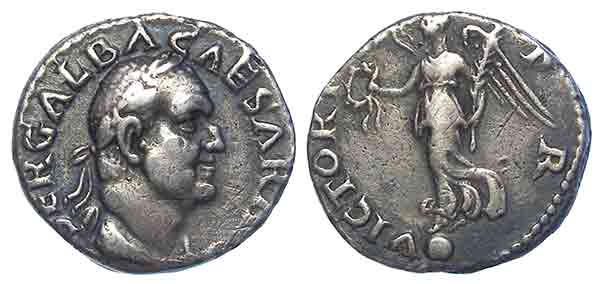
The look of this Galba denarius is that of old collection toning. It was probably once cleaned to bright metal and has been in a collection for decades slowly toning. It has be handled occasionally which reduced the toning on the high points and open areas of the background while the toning is darker in the more protected areas. Many collectors considered this the most desirable type of patina on ancient silver coins, but that is still subjective. It is not unusual for people to try to simulate old collection toning on a freshly toned coin but rarely will they get this varied degree of toning to look natural as it does on this coin. Silver coins with a subdued slightly toned silvery appearance are the norm and such appearance need not be described. Attractive natural toning can increase a coin's value, so one might want mention it. Bright silver coins should always be described as such, as should be unattractive toning that might look better on an image than it does on the coin in hand. Artificial (chemically-induced) toning which seldom looks natural should also be disclosed as some chemicals used to tone coins might continue to affect the coin over a long period of time. Experience will help with spotting the difference between natural and artificial toning. BRONZE COINSBronze patina can be complex and come in various forms, and collectors are split on what is most desirable. There are no rules as to what is the best patina. It is very subjective as to what the individual collector likes the most. 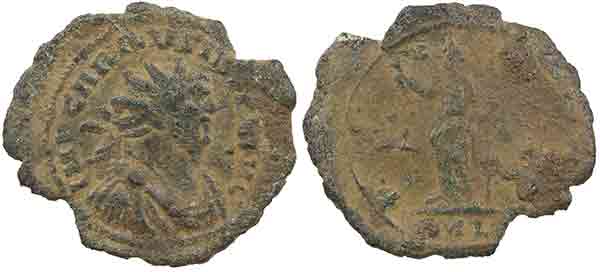
Most bronze coins are found with a layer of dirt on top, sometimes it will just wash off but more often it is cemented on by mineralization. This Carausius Antoninianus might have had loose dirt washed off, but that is the most that has been done to it. Cemented on dirt still coats most of the coin, and some collectors prefer this very natural look. In areas where there is no dirt one can see there is a brown patina below the dirt and some collectors might prefer the dirt left on and other that it were removed. 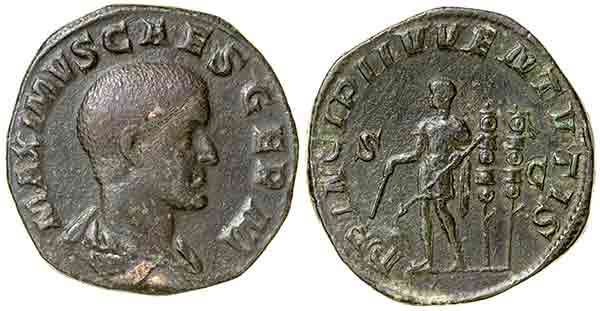
This Maximus sestertius has been cleaned to a mixed red-brown patina on the obverse, with a darker brown reverse. Minor amounts of the brassy metal is exposed on the high point of Maximus' head and a bit of the drapery on his shoulder. The reverse shows hints of green encrustations incompletely removed. I cannot be 100% certain what this coin looked like prior to cleaning, but the hints of patchy green suggest this coin was found with a layer of mottled patchy green over most of its surface and may have been unattractive until cleaned. This type of brown patina forms in dry climates, and tend to be more popular among American collectors. The brown layer is usually a copper oxide, would started forming while the coin was new in circulation. You know it today as the brown copper cents exhibit very quickly in circulation. Copper oxide comes in various colors but mostly reds, browns and blacks, and it is very common for an ancient bronze coin to have a mix of these colors across the surface, as we see on this example. Sometimes the effect is attractive and increases the value of a coin, and sometimes it is a detriment that decreases the value. Other times it is subjective as to what a particular collector prefers. 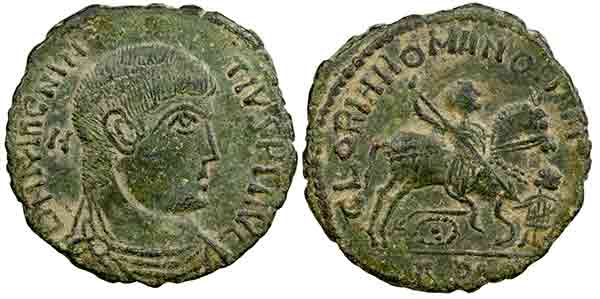
Green patina as seen on this Magnentius barbarous form in wetter climates. There is always a layer of brown below a green layer and one can see traces of it poking through at the high points. When a green layer forms this solidly and completely on a coin, cleaning it to remove the brown probably would end up with an ugly over cleaned coin, but since European collectors tend to prefer Green patinas, there is no reason one should ever want to remove a green patina list this. The light tan areas seen on some patches of this coin are original lightly cemented on dirt, and often leaving some of that in place highlights a coin, increasing it esthetic appeal. 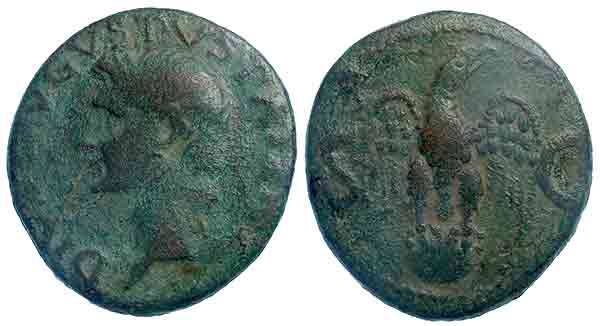
Sometimes one can have a fairly attractive mixed Green and brown patina as seen on the Divus Augustus bronze. The while this coin is somewhat worn and lacks some esthetic appeal in the grade, I find the patina quite attractive. 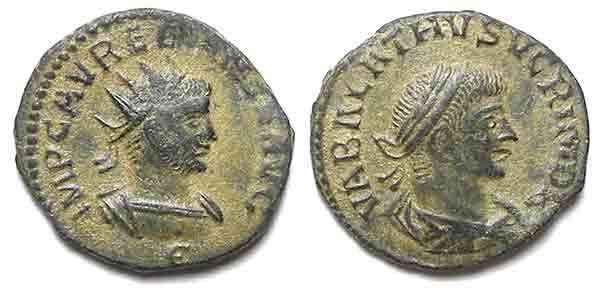
Another very attractive patina is called a desert patina, which we see on this Vabalathus and Aurelian antoninianus. This coin was buried in a very dry climate with significant light tan dust, which is what happens in deserts. When found the coin would have been completely covered in lightly cemented on tan dust covering the type of crown cuprite patina that forms in dry climates. The effect you see here comes from someone working very carefully to remove the tan dust and more importantly leave some of the tan dust, in just the right places to create a dramatic and attractive effect. This requires a skilled hand to get it right. One problem with desert patina is it can be falsified by cleaning a coin to just brown, and gluing dirt on to simulate this look. A quick soak in water and possibly rubbing alcohol will usually remove glued on dirt, and will not affect true desert patina. 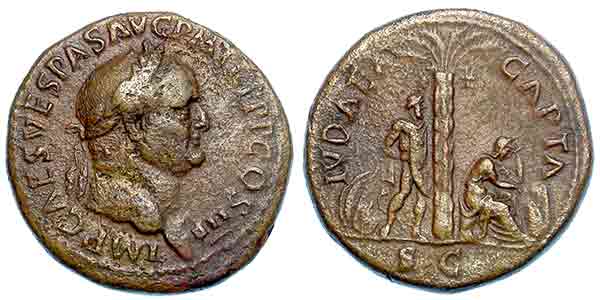
Bronze coins are sometimes seen with a Tiber Patina with this general look. A true Tiber patina forms on bronze coins found in anaerobic water such as the bottom of the Tiber River. Characterized by a natural subdued brassy color with no more than a thin layer of copper oxide, normally with very light pitting evenly over the surface. While this Vespasian sestertius has the general look of Tiber patina the heavy cuprite deposit on the lower right makes me wonder if this is a true Tiber patina or just something similar to it. What a Tiber Patina is not, is a coin simply stripped of a heavier patina to expose a brassy pitted surface. Very few coins come from the ground in high quality and attractive without significant cleaning beyond washing off some dirt. Such coins are prized by experienced collectors who recognize them, and command high premiums. More commonly such coins are found with encrustations that must be removed to reveal the coin's designs. When expertly done expertly the coin will look attractive with little evidence it had been cleaned, and such coins are also prized. When an inexperienced cleaner does things that removes the original patina or leaves obvious cleaning marks, the eye-appeal and thus the value can be adversely affected. I will deal more with that in the next section on damaged coins. This by no means covers all the patina types that exist but the over all it is all about how you feel about the way the coins looks when it is shown to you. There is no right or wrong about this, it is just personal feelings about it. Artificial patina is a specialized subject that cannot be dealt with in depth here. At its worst it can be as simple as a layer of paint, often will filled in pitting or other problems. There are chemically induced artificial patinas but these seldom look natural so experienced collectors can usually spot them. The effect of artificial patina on a coins value depends on how it affects the eye appeal but generally the value is reduced from a similar coin with a natural patina. The worst artificial patinas can render a coin almost worthless. 
Next page: Damaged coins Copyright © 2016 R & T Enterprises Ltd. |